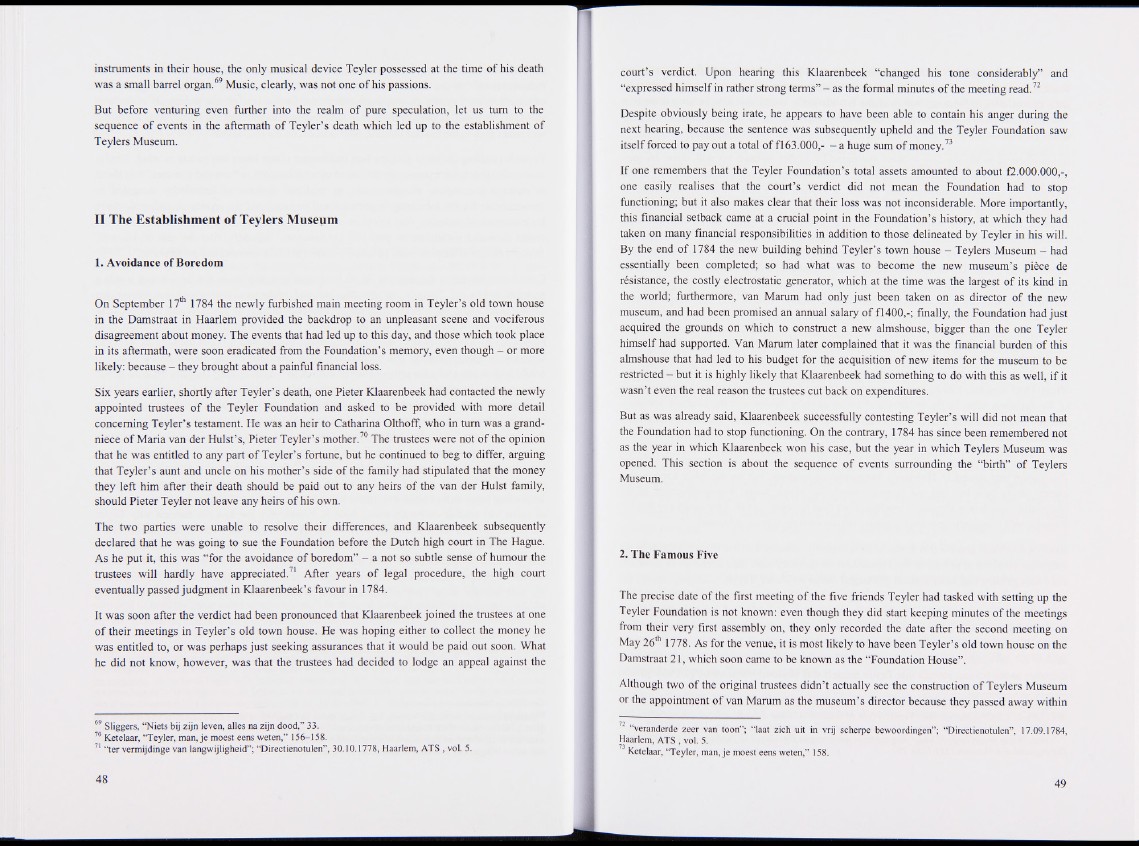
instruments in their house, the only musical device Teyler possessed at the time of his death
was a small barrel organ.69 Music, clearly, was not one of his passions.
But before venturing even further into the realm of pure speculation, let us turn to the
sequence of events in the aftermath of Teyler’s death which led up to the establishment of
Teylers Museum.
II The Establishment of Teylers Museum
1. Avoidance of Boredom
On September 17th 1784 the newly furbished main meeting room in Teyler’s old town house
in the Damstraat in Haarlem provided the backdrop to an unpleasant scene and vociferous
disagreement about money. The events that had led up to this day, and those which took place
in its aftermath, were soon eradicated from the Foundation’s memory, even though - or more
likely: because - they brought about a painful financial loss.
Six years earlier, shortly after Teyler’s death, one Pieter Klaarenbeek had contacted the newly
appointed trustees of the Teyler Foundation and asked to be provided with more detail
concerning Teyler’s testament. He was an heir to Catharina Olthoff, who in turn was a grand-
niece of Maria van der Hulst’s, Pieter Teyler’s mother.70 The trustees were not of the opinion
that he was entitled to any part of Teyler’s fortune, but he continued to beg to differ, arguing
that Teyler’s aunt and uncle on his mother’s side of the family had stipulated that the money
they left him after their death should be paid out to any heirs of the van der Hulst family,
should Pieter Teyler not leave any heirs of his own.
The two parties were unable to resolve their differences, and Klaarenbeek subsequently
declared that he was going to sue the Foundation before the Dutch high court in The Hague.
As he put it, this was “for the avoidance of boredom” - a not so subtle sense of humour the
trustees will hardly have appreciated.71 After years of legal procedure, the high court
eventually passed judgment in Klaarenbeek’s favour in 1784.
It was soon after the verdict had been pronounced that Klaarenbeek joined the trustees at one
of their meetings in Teyler’s old town house. He was hoping either to collect the money he
was entitled to, or was perhaps just seeking assurances that it would be paid out soon. What
he did not know, however, was that the trustees had decided to lodge an appeal against the
69 Sliggers, “Niets bij zijn leven, alles na zijn dood,” 33.
70 Ketelaar, ‘Teyler, man, je moest eens weten,” 156-158.
71 “ter vermijdinge van langwijligheid”; “Directienotulen”, 30.10.1778, Haarlem, ATS , vol. 5.
court’s verdict. Upon hearing this Klaarenbeek “changed his tone considerably” and
“expressed himself in rather strong terms” - as the formal minutes of the meeting read.72
Despite obviously being irate, he appears to have been able to contain his anger during the
next hearing, because the sentence was subsequently upheld and the Teyler Foundation saw
itself forced to pay out a total of f 163.000,— a huge sum of money.73
If one remembers that the Teyler Foundation’s total assets amounted to about f2.000.000,-,
one easily realises that the court’s verdict did not mean the Foundation had to stop
functioning; but it also makes clear that their loss was not inconsiderable. More importantly,
this financial setback came at a crucial point in the Foundation’s history, at which they had
taken on many financial responsibilities in addition to those delineated by Teyler in his will.
By the end of 1784 the new building behind Teyler’s town house - Teylers Museum I had
essentially been completed; so had what was to become the new museum’s pièce de
résistance, the costly electrostatic generator, which at the time was the largest of its kind in
the world; furthermore, van Marum had only just been taken on as director of the new
museum, and had been promised an annual salary of fl400,-; finally, the Foundation had just
acquired the grounds on which to construct a new almshouse, bigger than the one Teyler
himself had supported. Van Marum later complained that it was the financial burden of this
almshouse that had led to his budget for the acquisition of new items for the museum to be
restricted'^ but it is highly likely that Klaarenbeek had something to do with this as well, if it
wasn’t even the real reason the trustees cut back on expenditures.
But as was already said, Klaarenbeek successfully contesting Teyler’s will did not mean that
the Foundation had to stop functioning. On the contrary, 1784 has since been remembered not
as the year in which Klaarenbeek won his case, but the year in which Teylers Museum was
opened. This section is about the sequence of events surrounding the “birth” of Teylers
Museum.
2. The Famous Five
The precise date of the first meeting of the five friends Teyler had tasked with setting up the
Teyler Foundation is not known: even though they did start keeping minutes of the meetings
from their very first assembly on, they only recorded the date after the second meeting on
May 26th 1778. As for the venue, it is most likely to have been Teyler’s old town house on the
Damstraat 21, which soon came to be known as the “Foundation House”.
Although two of the original trustees didn’t actually see the construction of Teylers Museum
or the appointment of van Marum as the museum’s director because they passed away within
“veranderde zeer van toon”; “laat zich uit in vrij scherpe bewoordingen”; “Directienotulen”, 17.09.1784,
Haarlem, ATS , vol. 5.
Ketelaar, ‘Teyler, man, je moest eens weten,” 158.